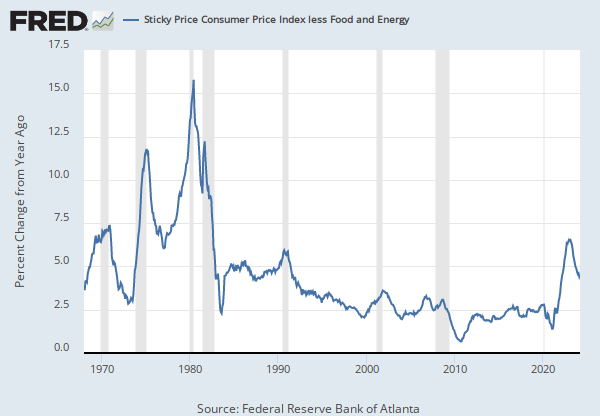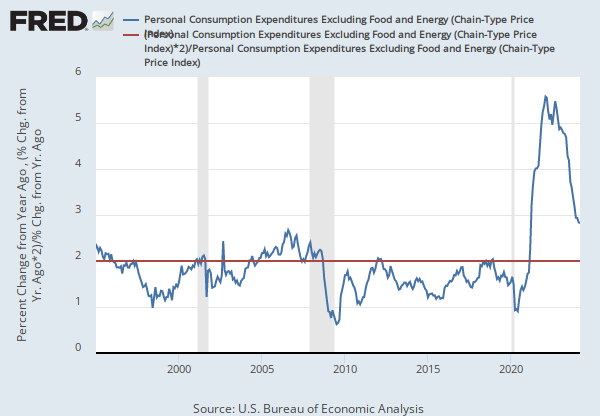FRED Graph
Data in this graph are copyrighted. Please review the copyright information in the series notes before sharing.
Notes
Source: U.S. Bureau of Economic Analysis
Release: Gross Domestic Product
Units: Index 2017=100, Seasonally Adjusted
Frequency: Quarterly
Notes:
BEA Account Code: DPCERD
For more information about this series, please see http://www.bea.gov/national/.
Suggested Citation:
U.S. Bureau of Economic Analysis, Personal consumption expenditures (implicit price deflator) [DPCERD3Q086SBEA], retrieved from FRED, Federal Reserve Bank of St. Louis; https://fred.stlouisfed.org/series/DPCERD3Q086SBEA, April 12, 2025.
Source: U.S. Bureau of Labor Statistics
Release: Consumer Expenditure Surveys
Units: U.S. Dollars, Not Seasonally Adjusted
Frequency: Annual
Notes:
For each time period represented in the tables, complete income reporters are ranked in ascending order, according to the level of total before-tax income reported by the consumer unit. The ranking is then divided into five equal groups. Incomplete income reporters are not ranked and are shown separately.
For more details about the data or the survey, visit the FAQs.
Suggested Citation:
U.S. Bureau of Labor Statistics, Income After Taxes: Income After Taxes by Quintiles of Income Before Taxes: Fourth 20 Percent (61st to 80th Percentile) [CXUINCAFTTXLB0105M], retrieved from FRED, Federal Reserve Bank of St. Louis; https://fred.stlouisfed.org/series/CXUINCAFTTXLB0105M, April 12, 2025.
Source: U.S. Bureau of Economic Analysis
Release: Personal Income and Outlays
Units: Index 2017=100, Seasonally Adjusted
Frequency: Monthly
Notes:
BEA Account Code: DPCCRG
The Personal Consumption Expenditures Price Index is a measure of the prices that people living in the United States, or those buying on their behalf, pay for goods and services. The change in the PCE price index is known for capturing inflation (or deflation) across a wide range of consumer expenses and reflecting changes in consumer behavior. For example, if car prices rise, car sales may decline while bicycle sales increase.
The PCE Price Index is produced by the Bureau of Economic Analysis (BEA), which revises previously published PCE data to reflect updated information or new methodology, providing consistency across decades of data that's valuable for researchers. They also offer the series as a Chain-Type index and excluding food and energy products, as above. The PCE price index less food excluding food and energy is used primarily for macroeconomic analysis and forecasting future values of the PCE price index.
The PCE Price Index is similar to the Bureau of Labor Statistics' consumer price index for urban consumers. The two indexes, which have their own purposes and uses, are constructed differently, resulting in different inflation rates.
For more information on the PCE price index, see:
U.S. Bureau of Economic Analysis, Guide to the National Income and Product Accounts of the United States (NIPA)
U.S. Bureau of Economic Analysis, Personal Consumption Expenditures Price Index
U.S. Bureau of Economic Analysis, Prices & Inflation
U.S. Bureau of Labor Statistics, Differences between the Consumer Price Index and the Personal Consumption Expenditure Price Index
Suggested Citation:
U.S. Bureau of Economic Analysis, Personal Consumption Expenditures Excluding Food and Energy (Chain-Type Price Index) [PCEPILFE], retrieved from FRED, Federal Reserve Bank of St. Louis; https://fred.stlouisfed.org/series/PCEPILFE, April 12, 2025.
Source: U.S. Bureau of Labor Statistics
Release: Consumer Expenditure Surveys
Units: U.S. Dollars, Not Seasonally Adjusted
Frequency: Annual
Notes:
For each time period represented in the tables, complete income reporters are ranked in ascending order, according to the level of total before-tax income reported by the consumer unit. The ranking is then divided into five equal groups. Incomplete income reporters are not ranked and are shown separately.
For more details about the data or the survey, visit the FAQs.
Suggested Citation:
U.S. Bureau of Labor Statistics, Income After Taxes: Income After Taxes by Quintiles of Income Before Taxes: Third 20 Percent (41st to 60th Percentile) [CXUINCAFTTXLB0104M], retrieved from FRED, Federal Reserve Bank of St. Louis; https://fred.stlouisfed.org/series/CXUINCAFTTXLB0104M, April 12, 2025.
Release Tables
- Third 20 Percent (41st to 60th Percentile): Income and Taxes
- Fourth 20 Percent (61st to 80th Percentile): Income and Taxes
Related Data and Content
Data Suggestions Based On Your Search
Content Suggestions
Other Formats
Personal consumption expenditures (implicit price deflator)
Annual, Not Seasonally AdjustedPersonal Consumption Expenditures Excluding Food and Energy (Chain-Type Price Index)
Percent Change from Quarter One Year Ago, Quarterly, Seasonally AdjustedRelated Categories
Releases
Tags
Permalink/Embed
modal open, choose link customization options
Select automatic updates to the data or a static time frame. All data are subject to revision.




































